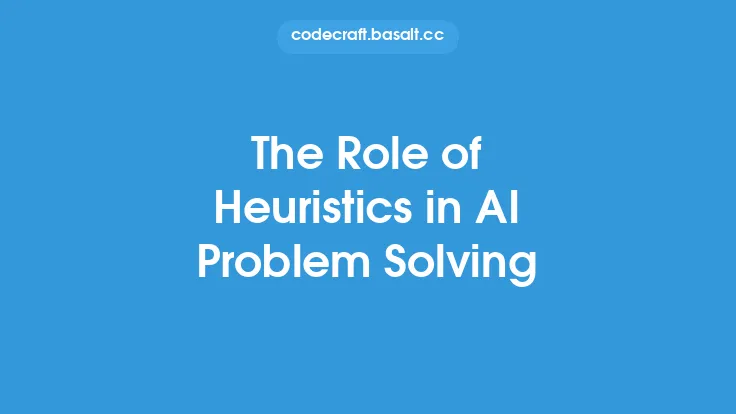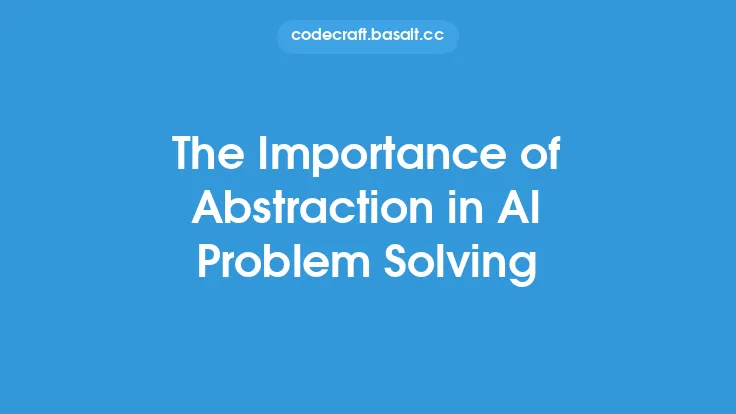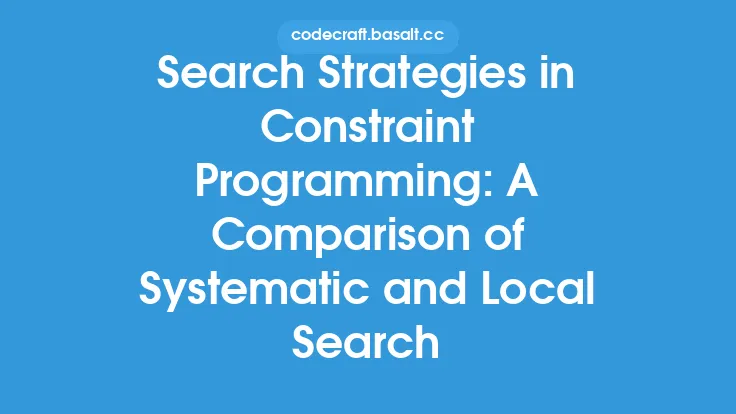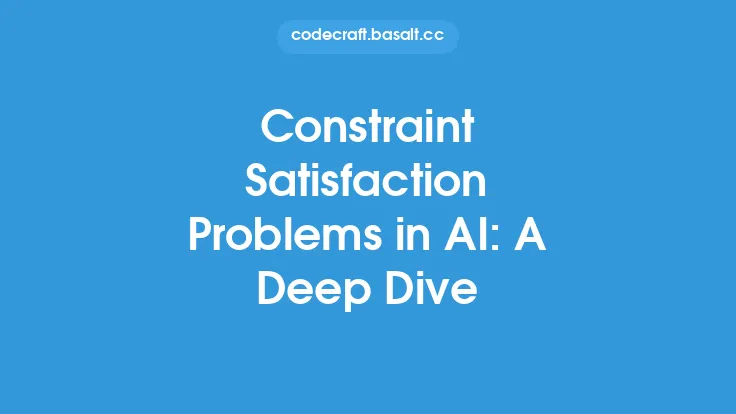Artificial intelligence (AI) has made tremendous progress in recent years, with significant advancements in areas such as machine learning, natural language processing, and computer vision. At the heart of these advancements lies the ability of AI systems to solve complex problems efficiently and effectively. Problem-solving strategies in AI are a crucial aspect of this field, as they enable machines to reason, learn, and adapt to new situations. In this article, we will delve into the world of problem-solving strategies in AI, exploring the various techniques, algorithms, and methodologies that underpin this fascinating field.
Introduction to Problem Solving in AI
Problem solving is a fundamental aspect of artificial intelligence, as it enables machines to navigate complex environments, make decisions, and achieve goals. AI systems use a range of problem-solving strategies to tackle challenges, from simple tasks such as sorting and searching to more complex problems like planning, reasoning, and decision making. These strategies are often inspired by human problem-solving techniques, but they are also shaped by the unique characteristics of AI systems, such as their ability to process vast amounts of data and perform complex computations.
Types of Problem-Solving Strategies in AI
There are several types of problem-solving strategies used in AI, each with its strengths and weaknesses. Some of the most common strategies include:
- Brute Force: This approach involves trying all possible solutions to a problem, often using exhaustive search algorithms. While brute force can be effective for simple problems, it can be impractical for more complex challenges due to its high computational cost.
- Divide and Conquer: This strategy involves breaking down complex problems into smaller sub-problems, solving each sub-problem, and then combining the solutions to form a complete solution. Divide and conquer is a powerful approach that can be used to solve a wide range of problems, from sorting and searching to more complex tasks like planning and decision making.
- Greedy Algorithms: Greedy algorithms are a type of problem-solving strategy that involves making locally optimal choices with the hope of finding a global optimum solution. While greedy algorithms can be effective for some problems, they can also get stuck in local optima, failing to find the best possible solution.
- Dynamic Programming: Dynamic programming is a method for solving complex problems by breaking them down into smaller sub-problems, solving each sub-problem only once, and storing the solutions to sub-problems to avoid redundant computation. This approach is particularly useful for problems that have overlapping sub-problems or that can be decomposed into smaller sub-problems.
Problem Representation in AI
Problem representation is a critical aspect of problem solving in AI, as it involves defining the problem, identifying the key variables and constraints, and specifying the goals and objectives. There are several ways to represent problems in AI, including:
- State Space Representation: This involves representing the problem as a set of states, where each state corresponds to a particular situation or configuration. State space representation is commonly used in planning and decision making, where the goal is to find a sequence of actions that transforms the initial state into a goal state.
- Graph Representation: Graph representation involves representing the problem as a graph, where nodes correspond to states or variables, and edges correspond to relationships or constraints between nodes. Graph representation is commonly used in problems like planning, scheduling, and resource allocation.
- Logical Representation: Logical representation involves representing the problem using logical formulas, such as propositional or first-order logic. Logical representation is commonly used in problems like reasoning, decision making, and knowledge representation.
Problem-Solving Algorithms in AI
There are many problem-solving algorithms used in AI, each with its strengths and weaknesses. Some of the most common algorithms include:
- Breadth-First Search (BFS): BFS is a search algorithm that involves exploring all the nodes at a given depth level before moving on to the next level. BFS is commonly used in problems like finding the shortest path between two nodes in a graph.
- Depth-First Search (DFS): DFS is a search algorithm that involves exploring as far as possible along each branch before backtracking. DFS is commonly used in problems like finding a path between two nodes in a graph.
- Dijkstra's Algorithm: Dijkstra's algorithm is a search algorithm that involves finding the shortest path between two nodes in a graph. Dijkstra's algorithm is commonly used in problems like routing and scheduling.
- **A\* Algorithm**: A\* algorithm is a search algorithm that involves finding the shortest path between two nodes in a graph using a heuristic function to guide the search. A\* algorithm is commonly used in problems like planning and decision making.
Applications of Problem-Solving Strategies in AI
Problem-solving strategies in AI have a wide range of applications, from simple tasks like sorting and searching to more complex challenges like planning, decision making, and reasoning. Some of the most significant applications of problem-solving strategies in AI include:
- Robotics: Problem-solving strategies in AI are used in robotics to enable robots to navigate complex environments, avoid obstacles, and perform tasks like assembly and manipulation.
- Computer Vision: Problem-solving strategies in AI are used in computer vision to enable machines to interpret and understand visual data, such as images and videos.
- Natural Language Processing: Problem-solving strategies in AI are used in natural language processing to enable machines to understand and generate human language, such as speech and text.
- Expert Systems: Problem-solving strategies in AI are used in expert systems to enable machines to reason and make decisions like human experts, such as diagnosing diseases or predicting stock prices.
Challenges and Limitations of Problem-Solving Strategies in AI
While problem-solving strategies in AI have made significant progress in recent years, there are still many challenges and limitations that need to be addressed. Some of the most significant challenges and limitations include:
- Scalability: Many problem-solving strategies in AI are not scalable to large and complex problems, requiring significant computational resources and memory.
- Optimality: Many problem-solving strategies in AI are not guaranteed to find the optimal solution, often getting stuck in local optima or failing to explore the entire solution space.
- Uncertainty: Many problem-solving strategies in AI are not designed to handle uncertainty, such as incomplete or noisy data, requiring significant modifications to handle real-world problems.
- Explainability: Many problem-solving strategies in AI are not transparent or explainable, making it difficult to understand why a particular solution was chosen or how it was derived.
Future Directions of Problem-Solving Strategies in AI
Despite the challenges and limitations, problem-solving strategies in AI continue to evolve and improve, with significant advances in areas like machine learning, deep learning, and reinforcement learning. Some of the most promising future directions of problem-solving strategies in AI include:
- Hybrid Approaches: Hybrid approaches that combine different problem-solving strategies, such as symbolic and connectionist AI, to leverage their strengths and overcome their weaknesses.
- Multi-Agent Systems: Multi-agent systems that involve multiple agents working together to solve complex problems, such as planning, decision making, and coordination.
- Cognitive Architectures: Cognitive architectures that simulate human cognition and provide a framework for integrating multiple problem-solving strategies, such as reasoning, decision making, and learning.
- Explainable AI: Explainable AI that provides transparent and interpretable solutions, enabling humans to understand why a particular solution was chosen or how it was derived.





